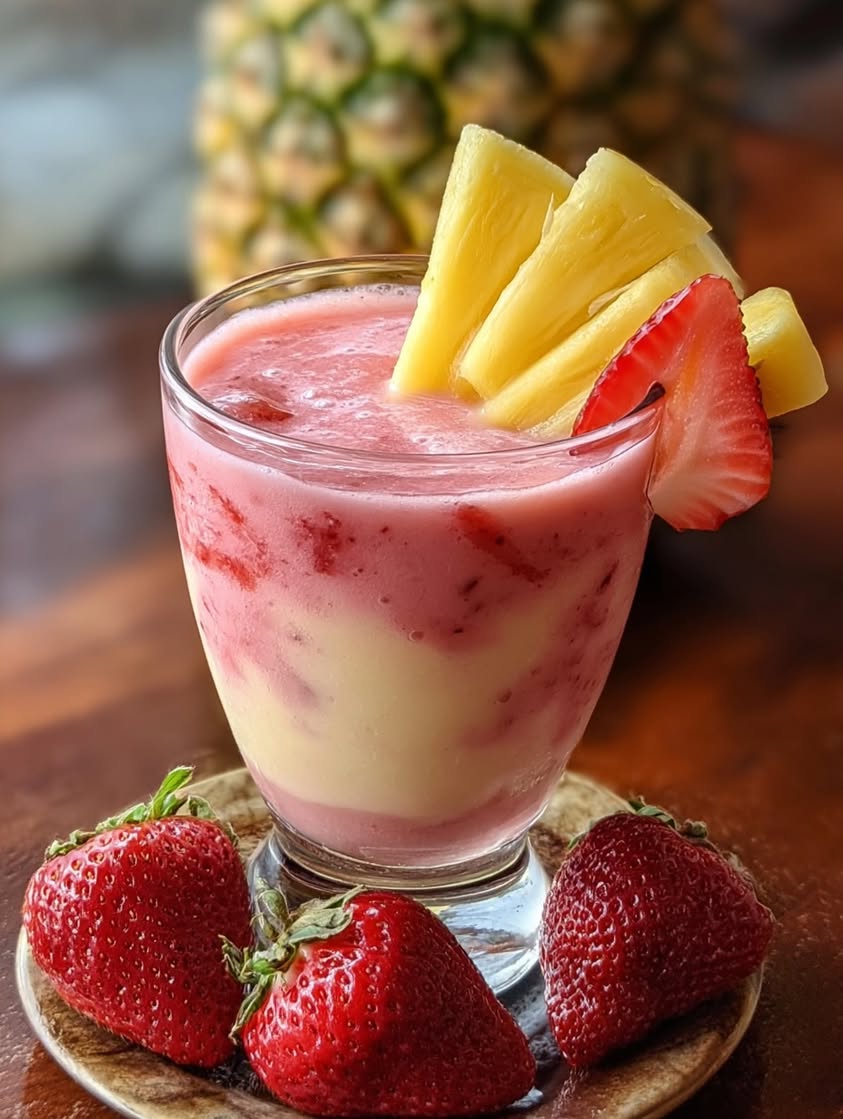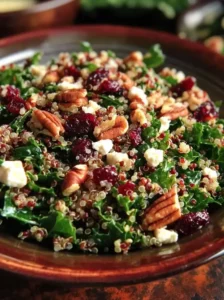Strawberry Piña Colada Smoothie: A Taste of the Tropics
Cool down with a refreshing Strawberry Piña Colada Smoothie, the perfect blend of tropical flavors and creamy texture that whisks you away to a sun-soaked beach. The sweet strawberries meld beautifully with the rich coconut and tangy pineapple, making each sip a delightful tropical escape. Whether you’re lounging by the pool or craving a fruity pick-me-up, this Strawberry Piña Colada Smoothie is your go-to recipe for a splash of summer in every glass.
Indulge your senses with this delightful recipe that balances the natural sweetness of strawberries and the exotic, lush taste of fresh pineapple. As you savor this vibrant drink, feel the smooth coconut cream’s silky touch transforming each sip into a decadent delight. With its striking color and inviting aroma, this Strawberry Piña Colada Smoothie is not just a drink; it’s an experience you’ll want to revisit time and again.
Quick Recipe Highlights
- Flavor Profile: This smoothie offers a delightful blend of sweet, tropical flavors with the fresh sweetness of strawberries combined with tangy pineapple and creamy coconut undertones.
- Texture: Expect a rich, creamy texture that offers a smooth and velvety mouthfeel, enhanced by the lush creaminess of coconut milk.
- Aroma: The distinctive fragrance of fresh strawberries and pineapple creates an inviting aroma that evokes the warmth of tropical locales.
- Visual Appeal: With its vibrant pink hue and creamy consistency, this smoothie is as visually inviting as it is delicious.
- Skill Level Needed: This recipe is designed for all skill levels, requiring only basic blending skills to achieve a perfect smoothie.
- Special Equipment: All you need is a good-quality blender to mix these ingredients into a silky smooth delight.
Recipe Overview
- Difficulty Level: Easy. The simplicity of combining fresh ingredients with a quick blend makes this an approachable recipe for any home chef.
- Category: This refreshing smoothie falls under beverages or breakfast smoothies, perfect for an energizing start to the day.
- Cuisine: A fusion of Caribbean influences, this smoothie reflects the bold and vibrant flavors central to tropical culinary traditions.
- Cost: Affordable and accessible, this recipe requires minimal ingredients that are often available year-round in most supermarkets.
- Season: Best enjoyed in the warmer months when fresh strawberries are at their peak, but equally delightful any time you crave a taste of summer.
- Occasion: Ideal for breakfast, brunch, or as a cooling afternoon treat during entertaining or relaxation.
Why You’ll Love This Recipe
Relish the natural sweetness and smooth texture of this Strawberry Piña Colada Smoothie that delights with each sip. Its vibrant mix of strawberries, pineapple, and coconut brings forth a medley of sweet and tropical notes, perfect for satisfying your cravings for a refreshing summer drink.
The convenience factor makes this smoothie a favorite; in just five minutes, you have a wholesome and tasty beverage ready to enjoy. It’s quick, requires no cooking, and the ingredients can often be adjusted to your taste preferences or dietary needs.
Besides being delicious, this smoothie is packed with nutrients from fruits that offer you vitamins, fiber, and antioxidants. Strawberries, with their high vitamin C content, coupled with the hydration benefits of coconut water, create a nourishing and revitalizing smoothie experience.
Entertaining with our Strawberry Piña Colada Smoothie is a breeze, effortlessly appealing to guests with its pleasing color and delightful aroma. It’s perfect for vibrant summer parties or a simple family gathering where both adults and kids alike can savor its delicious taste.
Another reason to love this recipe is its cost-effectiveness. With only a few accessible ingredients, you create a gourmet-tasting drink that won’t break the bank, making it an affordable option for day-to-day enjoyment.
Historical Background and Cultural Significance
The piña colada has origins deep within the tropical climates of the Caribbean, traditionally served as a cocktail that blends pineapple, coconut, and rum. This smoothie version maintains those essentials flavors, offering a non-alcoholic twist on a classic.
The cultural significance of using fresh fruits, such as strawberries and pineapple, echoes the tropical regions’ love for fruits in their cooking and beverages. These fruits are valued not just for their taste but also their refreshing and hydrating properties — crucial in warmer climates.
While the traditional piña colada hails from Puerto Rico, the smoothie variant brings a modern, health-conscious perspective, favoring fresh and natural ingredients over alcohol-centric classics, garnering appeal globally for all ages.
As culinary traditions evolve, this recipe demonstrates a fusion of preferences for health and taste, combining the ease of a smoothie with the nostalgic flavors of a beloved cocktail, creating regional variations that incorporate locally available produce or flavor tweaks.
Ingredient Deep Dive
Strawberries are not just delicious; they are packed with vitamin C and antioxidants, crucial for boosting immunity and skin health. Historically, they have been celebrated in many cultures for their sweetness and versatility in recipes.
Pineapples add a vibrant tropical flair, and are known for their digestive enzyme, bromelain, which aids in digestion and reducing inflammation. Selecting ripe, juicy pineapples ensures the perfect balance of tanginess and sweetness in the smoothie.
Coconut milk or coconut water imparts a creamy texture, rich in electrolytes and healthy fats. It’s a popular ingredient in tropical regions, known for its hydrating properties and deliciously creamy consistency.
Choosing the freshest ingredients is key to achieving the best flavor in this smoothie. Strawberries should be bright red and firm, while pineapples should be fragrant with a slight give when pressed.
For substitutions, frozen strawberries work well when fresh ones aren’t available. Canned pineapple can be used if fresh is out of reach, and almond milk or water can replace coconut milk for a lighter calorie option.
Common Mistakes to Avoid
- Using underripe strawberries or pineapple can result in a less flavorful smoothie. Always pick ripe, fragrant fruits for maximum taste.
- Over-blending the mixture may lead to a watery consistency. Blend just until the mixture is smooth to maintain its thickness.
- Neglecting to taste test as you go can lead to an imbalance in flavors. Adjust sweetness to your liking with natural sweeteners as necessary.
- Using too much ice can dilute the flavors. Consider freezing the fruits instead for a thicker, more flavorful result.
- Not cleaning the blender properly between uses can affect flavor and hygiene. Ensure thorough rinsing and drying before blending.
- Skipping the garnish can leave the smoothie looking plain. Fresh fruit pieces or coconut flakes add both taste and appeal.
- Not chilling the ingredients before blending will result in a less refreshing smoothie. Aim for cold or partially frozen components.
- Using canned coconut milk excessively may add unwanted fat content. Measure carefully and consider lighter coconut water for a fresher taste.
Essential Techniques
Blending is the key technique for this smoothie, demanding attention to speed and duration. Start with short bursts to chop the ingredients, then blend consistently for a smooth texture. Caution against over-blending to avoid heating the ingredients or thinning the drink.
Choosing ripe fruits ensures natural sweetness and reduces the need for additional sweeteners. Select fruits that are vibrant in color and aromatic for fresh, robust flavors.
Proper layering of ingredients in the blender is crucial: start with liquids, then soft fruits, and finish with dense ingredients. This encourages a more efficient blending process, reducing strain and achieving a smooth consistency.
Strain any unsatisfactory textures resulting from fibrous fruits through a fine mesh sieve. This ensures a seamless mouthfeel without compromising the drink’s natural flavors.
Pro Tips for Perfect Strawberry Piña Colada Smoothie
Enhance flavor depth by adding a teaspoon of vanilla extract or a dash of fresh lime juice to the blender for a tangy undertone.
To thicken the smoothie without additional calories, incorporate half a frozen banana. Its creamy texture complements the existing flavors and maintains a health-conscious profile.
Add more fiber and nutrients with a spoonful of chia seeds or flaxseeds, transforming the smoothie into a filling breakfast option.
For a protein-rich version, blend in a scoop of vanilla or coconut-flavored protein powder, perfect for post-workout recovery or as a meal replacement.
Use coconut cream in place of coconut milk for a richer, indulgent smoothie; ideal for special occasions or when craving a dessert-like treat.
For a vegan-friendly adaptation, ensure all ingredients, particularly coconut varieties or sweeteners like honey, adhere to plant-based choices.
Make the smoothie your own by experimenting with different fruit combinations: mangoes or passion fruit can introduce exciting new layers of flavor that complement the tropical theme.
Variations and Adaptations
Explore regional adaptations by incorporating available fruits such as mango or papaya, which naturally align with tropical flavors and provide a diverse taste palette.
For a seasonal twist, substitute strawberries with blueberries or raspberries during winter, creating a berry piña colada that retains tropical undertones.
Dietary modifications like lactose-free or plant-based milks ensure accessibility for those with dairy restrictions, without sacrificing creaminess or flavor.
Introduce a hint of spice with ginger or a sprinkle of ground nutmeg for an unexpected twist that elevates the drink into a unique flavor experience.
Adjust texture preferences by varying the base liquid; increase coconut water for a lighter, more hydrating version, or use coconut cream for a decadent, dessert-like beverage.
For dramatic presentation, serve in hollowed-out pineapples or coconuts, enhancing visual appeal and aligning with the tropical essence of the drink.
Serving and Presentation Guide
When serving the Strawberry Piña Colada Smoothie, choose tall, clear glasses to showcase its vibrant color. For an extra touch of elegance, chill the glasses in the freezer before use.
Enhance presentation with garnishes like fresh strawberry slices or pineapple wedges on the rim, and a sprinkle of toasted coconut for a sophisticated touch.
Accompany the smoothie with a small fruit skewer or a colorful cocktail umbrella for themed gatherings or simply to evoke a sense of summer vacation.
Consider serving the smoothie as a base for a breakfast bowl, topped with granola, fresh fruit slices, and a drizzle of honey or agave for a hearty meal.
Temperature is key: serve the smoothie ice-cold for optimal refreshment, especially on hot days, ensuring it’s always freshly blended before serving.
For portion control, use small tasting glasses at parties to offer guests a chance to enjoy without overindulgence, maintaining a balance of fun and health considerations.
Wine and Beverage Pairing
For a sophisticated pairing, opt for a light, crisp white wine such as a Sauvignon Blanc that complements the tropical fruit flavors without overshadowing the smoothie’s sweetness.
Non-alcoholic alternatives like sparkling water with a splash of lime or herbal iced teas offer a refreshing contrast when served alongside the smoothie, enhancing the overall tasting experience.
Coffee or tea pairings, like a chilled hibiscus tea or a fruity green iced tea, provide complementary caffeine boosts while aligning with the tropical theme.
Serve all pairings ice-cold, ensuring harmony with the smoothie’s chilling refreshment, potentially offering a new dimension of enjoyment with temperature contrasts.
Strong pairings should always consider balancing with the smoothie, either by complementing its fruity profile or offering a contrasting palate cleanser between sips.
Storage and Shelf Life
Store extra smoothie in a sealed jar in the refrigerator and consume within 24 hours to maintain freshness and flavor integrity.
Maintain an ideal storage temperature below 40°F (4°C) to preserve fruit vibrancy and prevent spoilage.
Use an air-tight container to limit oxygen exposure which can degrade the smoothie’s appealing color and taste over time.
Detect spoilage by observing any changes in smell or texture; the presence of an off-odor or bubbles indicates fermentation, suggesting disposal is necessary.
Reheating is not suitable for maintaining smoothie quality; instead, enjoy it cold or over ice if a chilled drink is required.
Freezing smoothie portions in ice cube trays offers an extended storage option for later use, facilitating easy remixing into new batches when defrosted.
Make Ahead Strategies
Prepare smoothie components ahead of time by chopping and freezing fruits in pre-measured portions, speeding up assembly on demand.
Store drink layers separately if desired: freeze fruit blends separately and mix with coconut elements just before serving for freshness.
Assess any impact on quality and adjust accordingly: fresh fruit flavors will shine best with immediate blending, with slight flavor loss possible upon extended storage.
Assemble ingredients into handy packs or smoothie kits for swift, no-hassle preparation, making it easy to blend anytime without sacrificing taste.
Enhance freshness by adding coconut water or a dash of lime just before serving—this prevents layering and keeps the texture velvety smooth.
Add fresh elements such as mint leaves or granola last-minute for texture and taste, providing contrast and a burst of fresh aroma when enjoyed.
Scaling Instructions
For couple servings, halve each ingredient for the same great taste and texture, adapting to smaller equipment if necessary.
Double or triple the recipe for family gatherings or parties, ensuring that blender capacity can accommodate increased volume without overheating.
Consider using larger blenders or industrial models when scaling up significantly, adapting timing to ensure smooth blending without strain.
A larger batch demands precision in timing and may require staggered blending to maintain the even distribution of flavors.
When preparing for bulk enjoyment, ensure that storage space accommodates pre-chilled glasses or servers to maintain intended serving temperature.
Even when scaling, prioritize fresh ingredients, as flavor compounds concentrate differently with batch adjustments, potentially impacting taste.
Nutritional Deep Dive
This smoothie is a powerhouse of nutrients, offering a macro breakdown featuring healthy carbohydrates from fruit, energizing natural sugars, and beneficial fibers.
Micronutrients abound with vitamins C, A, and potassium from strawberries and pineapple, offering targeted health advantages including immunity support.
Loaded with health benefits, the recipe supports hydration and anti-inflammatory effects, endorsed by fresh produce used at its peak.
With mock dairy-free alternatives, this drink can fit varied dietary plans, supporting lactose-intolerant individuals seeking tasty, refreshing options.
For weight management, the smoothie offers portion-defined servings with its caloric breakdown accessible for those tracking daily intake.
As a portion-friendly option, the smoothie controls indulgence while promising a flavorful, nutritious beverage aligning with balanced diet principles.
Dietary Adaptations
To make the smoothie gluten-free, ensure all selected ingredients, particularly pre-packaged coconut varieties or added enhancers, are certified gluten-free.
For a dairy-free adaptation, employ almond or soy milk instead of coconut milk, retaining creamy textures while aligning with specific dietary needs.
Vegan-friendly options include plant-based milks and sweeteners, omitting honey if traditionally used, ensuring full adherence to vegan principles.
Modify for low-carb preferences by focusing primarily on coconut water and limiting fruit quantities, prioritizing macronutrients in total intake.
The smoothie can fit low-FODMAP guidelines by careful selection of fruits meeting these parameters, verifying if strawberries or pineapples fit individual needs.
Adapt serving considerations for nutritional customization while respecting restrictions, allowing for a versatile beverage readily shaped to varied dietary needs.
Troubleshooting Guide
To resolve texture issues, too-thick smoothies can be thinned by adding coconut water; conversely, insufficient thickness can be tackled by frozen fruits or yogurt addition.
For flavor balance, assess sweetness meticulously—natural sweeteners can adjust tartness, or add a drizzle of honey to reduce acidity.
Temperature problems during blending may arise; avoid warming the mixture by blending in short bursts only until smooth.
If lacking key equipment, leverage stick blenders with the appropriate pitcher-sized container, handling potential spillage by covering and securing adequately.
Ice-related challenges necessitate ingredient substitution for similar consistency, such as frozen fruits instead of ice cubes if unavailable or shoehorned.
When timing raises concerns, pre-chop or measure ingredients to streamline blending, integrating assembly into niche time slots conveniently without hassle.
Recipe Success Stories
A community favorite, this smoothie often features glowing feedback, with many readers sharing personal twists, such as incorporating basil for an herbaceous finish.
Readers successfully adapt the base fruits to match available produce, maintaining the tropical notes while exploring fresh locales’ seasonal offerings.
Thematic variations created by users showcase creativity—adding small quantities of dark chocolate or spice infusions proves popular, earning high praise.
Suggestions also roll in about balancing ingredient freshness with preservation, showcasing several ingenious methods for optimization when adding or storing extra portions.
Photography tips shared emphasize the drink’s vibrant color, highlighting daylight props and glassware selections that elevate visual storytelling through styling techniques.
Frequently Asked Questions
Can I use other berries instead of strawberries?
Yes, you can substitute strawberries with any berries you prefer, like raspberries or blueberries. Keep in mind that different berries will alter the flavor profile slightly.
How can I sweeten the smoothie naturally?
You can add a touch of natural sweeteners like honey or agave syrup. Alternatively, a ripe banana can also enhance sweetness without refined sugar.
What is the best type of coconut milk for this recipe?
Use full-fat coconut milk for a creamy texture, but if you prefer a lighter version, coconut water or light coconut milk will work well without compromising flavor.
Can I prepare this smoothie in advance?
It’s best enjoyed fresh; however, you can prep the fruit in advance and freeze it. Blending should be done just before serving to maintain the richest texture.
What if the smoothie is too runny?
To thicken, add frozen fruit or a small amount of Greek yogurt, adjusting to your preferred consistency. A few ice cubes can also help achieve desired thickness.
Is this smoothie suitable for children?
Absolutely! It’s an excellent choice for kids, offering a nutritious blend of fruits and coconut, perfect as a breakfast or healthy snack option.
What is the calorie count per serving?
Each serving contains approximately 150-200 calories, depending heavily on variations. For precise calculations, consider all ingredients and portions utilized.
Can I incorporate protein into this smoothie?
Yes, a scoop of vanilla or unflavored protein powder can integrate seamlessly, enriching nutrient content for those seeking a more substantial post-exercise drink.
How do I avoid bitterness in my smoothie?
It may stem from unripe fruit; ensure your ingredients are ripe and add a dash of sweetness, like vanilla extract, to counter any lingering bitterness.
What if I don’t like coconut flavor?
Replace coconut milk with almond or soy milk, offering a neutral base while still achieving a creamy texture, maintaining pleasant smoothie characteristics.
Additional Resources
Explore related recipes such as mango or pineapple smoothies that follow similar processes, assisting in broadening smoothie repertoire through fostering familiar methods.
Guides detailing the importance of ingredient ripeness prove informative, emphasizing how proper selection dictates final taste and freshness, enhancing smoothie quality.
Equipment recommendations highlight top picks for blenders routinely praised for reliability and ease, essential staples for smoothie creation and blending prowess.
Investigate seasonal fruit charts and availability lists for an in-depth view into optimal timing for obtaining fresh ingredients, ensuring peak flavors irrespective of location.
By adopting the tips shared here, achieving consistently tasty smoothies becomes second nature, harmonizing technique, ingredient choice, and presentation alike.
Print
Strawberry Piña Colada Smoothie
Description
A refreshing smoothie combining the tropical flavors of pineapple and coconut with the sweetness of strawberries.
Ingredients
For the Crust:
- 1 cup fresh strawberries, hulled
- 1/2 cup pineapple chunks
- 1/2 cup coconut milk
- 1/2 cup Greek yogurt
- 1 tablespoon honey
- 1 cup ice cubes
Instructions
1. Prepare the Crust:
- Place the strawberries, pineapple chunks, coconut milk, Greek yogurt, and honey in a blender.
- Blend on high speed until smooth and creamy.
- Add the ice cubes and blend again until smooth. Serve immediately.
Notes
You can customize the seasonings to taste.





